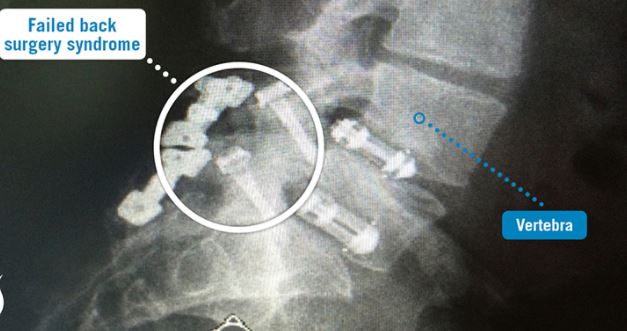We Are Failed Back Surgery Syndrome Experts
state of the art ultrasonic Failed Back Surgery Syndrome Treatment
What is Failed Back Surgery Syndrome ?
FBSS is a generalized term that is used to describe the condition of patients who have experienced unsuccessful results following spine surgery to treat neck or back pain. Specifically, the term applies when spine surgery has not alleviated the original problem or has created other, more significant problems, resulting in continuing or worsening pain.
It is estimated that up to 40 percent of patients who undergo traditional open back surgery experience failed back surgery syndrome. The incidence of failed back surgery syndrome, or FBSS, depends upon many factors. For instance, FBSS tends to occur more frequently in the lumbar (lower) region than in the cervical (upper) region of the spine. Additionally, your risk of developing FBSS is much higher following an open spinal fusion procedure than after undergoing a minimally invasive technique.
Based on the studies published to date by the U.S. National Institutes of Health, the only scientifically defendable statement that can be made about the incidence of failed back surgery syndrome is that its likelihood increases with the invasiveness of the spinal surgery that was performed.

What Are The Causes Of Failed Back Surgery Syndrome?
While failed back surgery syndrome does not always develop after spine surgery, there are certain factors that can increase the risk of developing this condition, such as:
- Failure to properly identify the condition(s). Surgeons who see a low volume of patients with degenerative spine conditions tend to be less experienced and specialized in diagnosing and treating these conditions. As a result, when determining the underlying cause of a patient’s neck or back discomfort, a relatively inexperienced surgeon might attempt to correlate a patient’s pain pattern with a specific area of degeneration in the spine. However, the process of making an accurate diagnosis is not always this straightforward.
Additionally, other sources of pain, such as hip osteoarthritis, can produce symptoms that are very similar to, and therefore often incorrectly attributed to, degenerative spine conditions. Based on an improper diagnosis, a surgeon might perform surgery at the wrong level of the spine or otherwise improperly treat the condition, leading to FBSS.
- Failure to adequately decompress a nerve root or otherwise treat the condition(s). A technical error on the part of a treating surgeon, such as leaving behind a bone fragment or some herniated disc material that is pressing on a nerve root or the spinal cord, can result in pain that continues or worsens after surgery.
- Spinal fusion failure. The goal of a traditional spinal fusion procedure is to relieve nerve compression by removing a damaged disc and stabilizing the adjacent vertebrae with bone grafts or implants that are naturally fortified as the body heals after surgery. However, in order to successfully address neck or back pain through spinal fusion, a surgeon must first accurately identify the source of a patient’s pain. Furthermore, every patient heals at a different rate. Because vertebral fusion takes place as part of the healing process, it can take up to several months to achieve a solid fusion in some patients, while it never fully occurs in others.
- Implant migration. Sometimes, an implant can shift after being placed by a surgeon. This most often occurs during recovery, before the body’s healing process has progressed to the point that the implant has attached firmly to the vertebrae. An implant that has moved out of its intended spot will be less effective — or completely ineffective — at stabilizing the spine. Moreover, if a displaced implant compresses sensitive neural tissue, it could create a painful new spine condition.
- Scar tissue formation. As part of the natural healing process, the body forms bands of scar tissue following any form of tissue disturbance, such as spine surgery. These fibrous adhesions can potentially bind a nerve root, resulting in a condition called epidural fibrosis, which can lead to postoperative pain and FBSS.
- Nerve damage. Decompressing a nerve root through spine surgery will typically cause temporary inflammation and can lead to increased pain until the inflammation subsides. However, in rare cases, nerve damage can occur, resulting in symptoms like chronic pain and weakness in certain muscle groups.
Am I the right patient for Failed Back Surgery Syndrome Treatment?
If you have failed back syndrome, call us about the SonoSpine Procedure